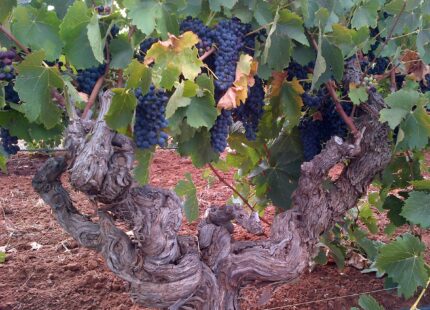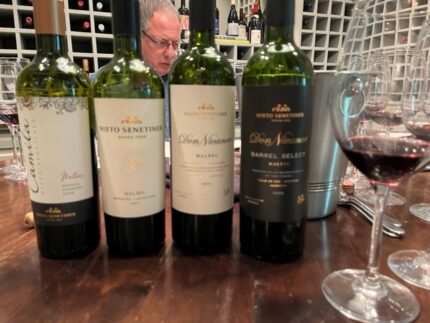Writing a blog for over a decade offers a unique perspective on witnessing change – be it in the vineyards, the people, the wines, or the regions. Seven years ago, I had the privilege of sitting down with winemaker Santiago Mayorga of Nieto Senetiner, who had just completed his first year in this relatively new role.
While the core story of Nieto Senetiner Winery is a tale of tradition, passion, and a commitment to producing exceptional wines, it was fun to catch up with Santiago to talk about several changes that have happened since we first met.

The Past
The winery was founded in 1888 by Italian immigrants in Vistalba, Luján de Cuyo, the region of Mendoza that would give birth to the Argentine wine industry.
In 1969, the Nieto and Senetiner families acquired the estate, embarking on a path of expansion and modernization. Their initial steps included planting the first vineyards and crafting their wines, which have been recognized as some of Argentina’s best. The formative years of the winery were defined by the commitment and efforts of these families as they cultivated their vineyards and made wines, primarily catering to the local community. The winery’s vineyards are primarily located in Luján de Cuyo and the Uco Valley, two renowned wine-producing regions in Mendoza, where the high-altitude vineyards, ample sunshine, and ideal soil conditions contribute to the production of premium grapes.
In 1998, Nieto Senetiner was acquired by Molinos Río de la Plata, one of the country’s leading food and beverage companies. Committed to the highest winemaking and quality standards, it established itself as an industry leader by developing a portfolio of well-known brands.
In 2013, Santiago was named winemaker and is known for his innovative approach to winemaking, which involves traditional and non-traditional varietals. In the past, Santiago worked at Catena Zapata and Zuccardi Valle de Uco.
The Present
Nieto Senetiner has grown and evolved, becoming a respected name in the Argentinian wine industry. The winery has always embraced the traditional winemaking methods that have been passed down through the generations, but it has also embraced innovation and modern techniques to further improve the quality of its wines.
The winery has engaged in a range of sustainability initiatives, demonstrating its dedication to environmental stewardship and the conservation of the region’s precious natural resources.
The Changes
The first changes expanded and modernized the winemaking processes while preserving the winery’s traditions and heritage. In 2014, Foley Family Wines added Nieto Senetiner to its portfolio of wines, which includes 17 wineries and three import partners across the globe. Other changes included refreshing the brand and incorporating more modern technology.
Santiago also took a fresh look at Malbec and how he could differentiate it from others in the region by moving to some techniques used in many burgundy wines, which would show the terroir and varieties. He wanted to adapt to new styles, grapes and make artisanal wines totaling ten varietals today.

We tried a variety of the winery’s seven labels (plus sparkling wine) during our lunch at Dragonfly. I tried several Malbecs, but they were differentiated.
- 2020 Nieto Senetiner Patrimonial Semillon – I really enjoyed this wine. I tasted notes of jasmine, citrus, lemon, honey, and peaches. Semillon is made in Argentina, Australia, South Africa, and California and this comes from some of the oldest vines in Argentina.
- 2022 Camila Malbec by Nieto Senetiner – This was a very approachable wine that has notes of plum, cassis, vanilla, chocolate, black fruit, and spice.
- 2022 Nieto Senetiner Malbec – Notes of berries, cherries, caramel, spice, and violets.
- 2015 Nieto Senetiner Don Nicanor Single Vineyard ‘Villa Blanca’ Malbec – The Nieto winery is in Vistalba, known for its old-vine malbec. I tasted lots of red fruit, dried flowers, spice, dark chocolate, and lavender. Savory and elegant.
- 2019 Nieto Senetiner Villa Blanca Estate Malbec – This one was more intense but still elegant. I tasted dried fruit, spice, Earl Gray tea, chocolate, and cedar.
- 2020 Nieto Senetiner Villa Blanca Estate Malbec – I tasted much more fruit in this vintage. Notes of blackberry, anise, spice, and tea.
- 2021 Nieto Senetiner Don Nicanor Malbec – This is a juicy wine that represents what I’ve typically tasted in an Argentina Malbec. There were notes of blackberry, Asian spice, lavender, black cherries, and purple flowers.
- 2016 Nieto Senetiner Don Nicanor Barrel Select Malbec – I tasted blackberries, plum, black cherries, currant, vanilla, violet, lavender, and spice. I loved the evolution of this wine in the glass and in the bottle.
- 2020 Nieto Senetiner Don Nicanor Barrel Select Malbec – I tasted red and black fruit, chocolate, vanilla, pepper, and dried herbs. It had structure but is a great wine to cellar.
- 2021 Nieto Senetiner Don Nicanor Malbec – I tasted notes of red fruits, black fruit, violets, spice berries, violets, and vanilla. This was more of a traditional Malbec, but still had subtleties to it.
- 2015 Nieto Senetiner Single Vineyard Finca Villa Blanca Malbec – this wine comes from a single vineyard planted in 1900. I tasted red and black fruit, chocolate, oak, vanilla, and leather. It was a splendid wine.
Santiago shared his vision of preserving Mendoza’s narrative through a relentless commitment to quality, a deep connection to the land and its people, and the enduring legacy of exceptional wine.



